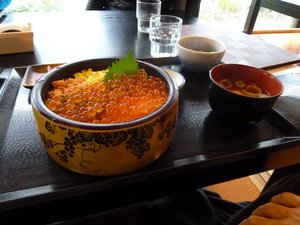Advertisement
Published: November 15th 2015

 Mark's oyako-don
Mark's oyako-don
Rice with salmon, salmon roe, eggs, miso, and picklesKuji, north edge of Sanriku Railway, is home for Amachan, a female diver on Kosode coast, which was dramatised on the NHK – Nippon Hoso Kyokai: Japan Broadcasting Corporation, between April and September 2013. I felt this city was rather quiet. We walked to Michi no Eki (The property is located in the middle of tourist destinations and houses facilities for tourists such as tourist information centre, restaurants, and supermarkets selling fresh fish, meats, dairy products and vegetables taken from local farms and fishermen) Kuji, Yamase Dufukan (House of the ground and wind). It was just 10 minutes’ walk from the station.
Although it wasn’t lunch time, we firstly entered the restaurant ‘Sankairi’. It was at 11:30 when we sat the table, but the restaurant was nearly a full-house. My father took a set menu (with rice, miso soup and pickles) with tempura, Mark selected a set menu with oyako-don – salmon & salmon roe, I had a set menu with raw fish collection – tuna, bonito, octopus, swordfish and salmon, and my mother chose a set menu of Kohaku-don, which had been introduced on the television and in the magazines. Her meal was served with a big portion containing
assorted raw fish, pork and beef and came with the strap with amber’s jewellery.
Next, we entered the house of the wind. We looked round exhibitions of Amachan. It included costumes, goggles, fishermen’s baskets with sea urchins and abalones. We also saw a big float with ornate decorations which is used for the autumn festival in Kuji. The house of the wind was combined with the tourist information centre; my mother asked the receptionist if she could offer an idea that would allow us to stroll through the town within an hour.
She recommended us that we would go to the park and Tatsumiyama Inari shrine near Yamase Dofukan. Standing on higher ground, we could overlook the city including the railway station, residential houses and shopping department buildings and see the harbour beyond. We found Torii, a red-coated gate for the shrine and steps leading to Tatsumiyama Inari Shrine. Beside the gate, we found the panel of Kuji-born celebrity, Kyuzo Miyoshi. He was a great Judo technician and undertook the role of the referee for the Judo tournaments for Tokyo Olympics. He also wrote a classic book with the title of ‘The canon of Judo’.
We came
back to Yamase Dofukan. We looked at the float and its decorations and photos of Kuji’s autumn festival, and the fossilized tree resin displayed at Kohaku museum. Kohaku is the amber and it has been appreciated since Neolithic times, and been used as an ingredient in perfumes and its gemstones are used for jewellery. There were collections of paintings of Sanriku coast and countryside in Iwate prefecture and photographs of Kuji’s old days displayed on the 1
st floor. Kuji suffered the tsunami disasters 4 years ago, particularly around the harbour: the tank for Japan Underground Oil Storage Corporation was knocked down, and Moguranpia, the aquarium, which was the multi-facility building of Oil Culture Hall, run by the above named company, was devastated. There were photos of the engulfing tsunami and destruction on the wall.
On the way back to the station, we popped in ‘Machinaka Moguranpia (aquarium), which has been temporarily opened by the station in the middle of the town, and saw a wide variety of fish, seashells, amphibians, reptiles and amazing species like a blue-sea turtle which survived the disaster.
Advertisement
Tot: 0.166s; Tpl: 0.011s; cc: 14; qc: 58; dbt: 0.0988s; 1; m:domysql w:travelblog (10.17.0.13); sld: 1;
; mem: 1.1mb

 Mark's oyako-don
Mark's oyako-don